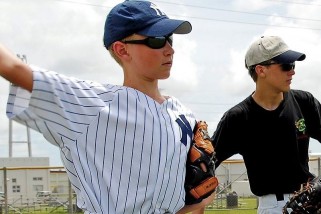BreakingModern — These days, professional baseball teams only average about four runs per game. That’s pretty bad. Not to sound alarmist, but major league baseball is in danger of losing its younger audience – i.e. the future of the game.

It’s not like the league is falling apart, however. Nine billion dollars were deposited into its coffers last season. According to a recent article in Forbes magazine, profits are at an all-time high. From an accounting perspective, baseball has never been more popular. But the younger fans demand more scoring and more drama.
Something has to change for the long-term health and success of the game. Shrinking the strike zone to help hitters is simply wrong, as is lowering the mound. Traditionalists and sabermetricians would despise any radical changes to the game simply to cater to casual fans. In the big leagues, pitching talent is at the highest level it’s been in generations. Making knee-jerk changes to the rulebook would surely devalue the current fraternity of this very specialized group. Any quick fix will just be detrimental to the game as a whole.
Specialization: Hurting Baseball?
Specialization, not the height of the mound or the size of the strike zone, is what leaves baseball desperate for offense. In this era of the “travel club,” players are being groomed to play just one sport. These days, kids enter the club system as early as seven years old.
On the surface, this doesn’t seem like a problem, but rather, a positive. Specialization gives players more experience in the sport. It builds up their skills and makes them more efficient and streamlined ballplayers.
However, upon further inspection, specialization actually decreases the talent pool for hitters, putting pitchers at a disadvantage. Specialization has pervaded the U.S. sports culture on the macro level by emphasizing one sport — and in that sport, one position.

Designated Hitters: Diluting the Talent Pool
Specialization inevitably makes pitchers more polished despite concerns about “Tommy John surgeries.” But many coaches in high school and college pull their star pitchers from the batting roster (via the designated hitter rule). This helps prevent needless mishaps, but it also prevents the kids from developing into well-rounded players. And in the end, it robs baseball of a large number of quality hitters.
These pitchers don’t get the opportunity to swing the bat during a game. So if they blow out their arm on the mound, they can’t contribute to their team in any meaningful way. Pitchers are good athletes. Given the chance (and the reps), they have the potential to be good hitters too.
At the high school level, pitchers make up about half of the squad. But with the DH rule in place, they get little or no chance to prove themselves as hitters. This rule follows players all the way through college and most of the minor leagues as well.
Yes, pitching in major league baseball is getting better and better. But along with that, the pool of sluggers is getting more and more shallow. The regression of talent is inevitable. Specialization, coupled with the implementation of the designated hitter, has created auspicious conditions for pitchers.
The DH trend dilutes the overall quality of play, and it’s the reason most pitchers (not named Madison Bumgarner) cannot step into the batter’s box once they reach the big leagues. Eliminating the DH and reducing specialization in high school and travel ball would be a 10- or 15-year solution. But it would be a healthy way of injecting offense into baseball.
For BMod, I’m Ben Leonard.
Featured Image: Youth Baseball: Wikimedia Commons
Second Image: Wil Nieves: Wikimedia Commons







![Will College Football (As We Know It) Cease to Exist? [commentary]](../wp-content/uploads/2015/09/header-321x214.png)



![Soccer Rally 2: World Championship [review]](../wp-content/uploads/2015/08/header7-321x214.jpg)
![Blitz: The League II [review]](../wp-content/uploads/2015/08/header6-60x60.jpg)

![Rocket League [review]](../wp-content/uploads/2015/08/header2-60x60.jpg)
![Injustice: Gods Among Us [review]](../wp-content/uploads/2015/07/HEADER3-60x60.jpg)